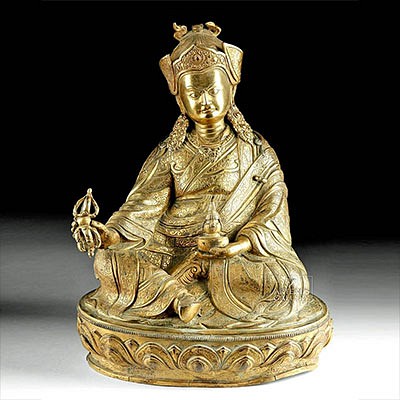19th C. Tibetan Fabric Thangka - Herukas
Lot 101a
About Seller
Artemis Fine Arts
686 S Taylor Ave, Ste 106
Louisville, CO 80027
United States
Selling antiquities, ancient and ethnographic art online since 1993, Artemis Gallery specializes in Classical Antiquities (Egyptian, Greek, Roman, Near Eastern), Asian, Pre-Columbian, African / Tribal / Oceanographic art. Our extensive inventory includes pottery, stone, metal, wood, glass and textil...Read more
Categories
Estimate:
$900 - $1,200
Absentee vs Live bid
Two ways to bid:
- Leave a max absentee bid and the platform will bid on your behalf up to your maximum bid during the live auction.
- Bid live during the auction and your bids will be submitted real-time to the auctioneer.
Bid Increments
| Price | Bid Increment |
|---|---|
| $0 | $25 |
| $300 | $50 |
| $1,000 | $100 |
| $2,000 | $250 |
| $5,000 | $500 |
| $10,000 | $1,000 |
| $20,000 | $2,500 |
| $50,000 | $5,000 |
| $100,000 | $10,000 |
| $200,000 | $20,000 |
About Auction
By Artemis Fine Arts
Mar 11, 2021
Set Reminder
2021-03-11 12:00:00
2021-03-11 12:00:00
America/New_York
Bidsquare
Bidsquare : Art of Asia | Antiquity to Present
https://www.bidsquare.com/auctions/artemis-gallery/art-of-asia-antiquity-to-present-6497
Featuring antiquities, ancient and works of art ranging from the third millennium BCE to the present from China, Japan, South and Southeast Asia, and Korea. Including jades, bronzes, lacquer, textiles, paintings, prints, sculpture, ceramics, metalwork, and other art forms in other media. Artemis Fine Arts info@artemisfinearts.com
Featuring antiquities, ancient and works of art ranging from the third millennium BCE to the present from China, Japan, South and Southeast Asia, and Korea. Including jades, bronzes, lacquer, textiles, paintings, prints, sculpture, ceramics, metalwork, and other art forms in other media. Artemis Fine Arts info@artemisfinearts.com
- Lot Description
Central Asia, Tibet, late 19th to early 20th century CE. An antique Tibetan thangka with a fierce Heruka theme, so finely painted with rich hues as well as gold leaf details. Herukas are wrathful deities assuming savage phenotypes in order to protect Buddhism from threatening enemies. They function as yidam to protect believers. Note that the Heruka depicted in the center of this thangka presents traditional attributes of wrathful deities including a headdress with five skeletal death heads (a macabre variant of a crown with five flower petals to indicate the five dhyani buddhas used for more peaceful deities) as well as a long necklace of skulls. Also depicted on the thangka are other heruka figures as well as more peaceful dhyani buddhas - all set within a verdant landscape and a deep blue sky - and at the apex of the composition is Tsongkhapa (1357-1419) wearing his traditional yellow hat. Tsongkhapa would be named the first Dalai Lama after his death. (See more on Tsongkhapa below). All is sewn within a lovely surround of decorative silken fabrics of warm red and golden hues Size: 48.5" L x 39.5" W (123.2 cm x 100.3 cm)
Tsongkhapa's abhorrence of the laxity of many monastic orders gave rise to a strong foundation for the Order of the Virtuous, the Gelugpa. Since the Gelugpas wore yellow hats, this order is sometimes referred to as the Yellow Hats, distinguishing it from other orders called Red Hats. Tsongkhapa is known for restoring monastic discipline, the prohibition of the use of alcohol, and requiring strict celibacy as well as a regimented daily schedule. His honorary title is Je Rinpoche -Je meaning "exalted".
According to Meulenbeld's "Buddhist Symbolism in Tibetan Thangkas (2004): "Tsongkhapa was born of poor parents in Amdo, Eastern Tibet, in the Onion Valley. His keen intelligence was evident when he was little. At a young age, he received various degrees from his studies in Central Tibet where he mastered five main subjects taught by a Tibetan monastery university: abhidharma (metaphysics), madhyamika (the Middle Way, between Being and Non-Being), prajnaparamita (knowledge), pramana (logic), and vinaya (monastic rules) . . . Tsongkhapa founded large monasteries and universities, such as Ganden, Drepung, and Sera."
Due to the vow of celibacy, hereditary succession was not possible. The solution was to designate a new monastery abbot or lama as an incarnation of his predecessor. From this arose the succession to Yellow Hats leadership, including the Dalai Lama who is regarded as an incarnation of Avalokiteshvara. This line of Dalai Lamas began in the 16th century. Following his death, Tsongkhapa was retroactively named the first Dalai Lama.
Provenance: private collection, Beaverton, Oregon, USA
All items legal to buy/sell under U.S. Statute covering cultural patrimony Code 2600, CHAPTER 14, and are guaranteed to be as described or your money back.
A Certificate of Authenticity will accompany all winning bids.
We ship worldwide and handle all shipping in-house for your convenience.
#150964Slight age wear and a few minor areas of discoloration to the painting. Fabric on verso has darkened with age and there are some frayed areas/losses to the verso. The silken fabrics that surround the painting were likely added later, but complement the painting very well.Condition
- Shipping Info
-
All shipping is handled in-house for your convenience. Your invoice from Artemis Gallery will include shipping calculation instructions. If in doubt, please inquire BEFORE bidding for estimated shipping costs for individual items.
-
- Buyer's Premium



 EUR
EUR CAD
CAD AUD
AUD GBP
GBP MXN
MXN HKD
HKD CNY
CNY MYR
MYR SEK
SEK SGD
SGD CHF
CHF THB
THB














